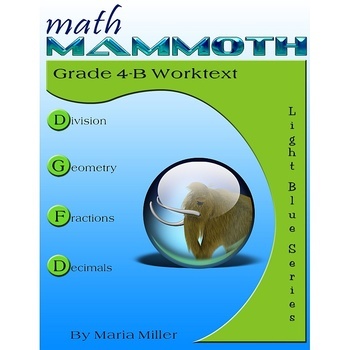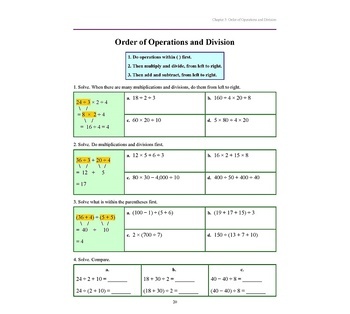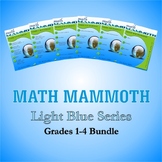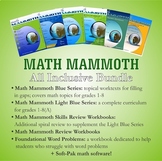Math Mammoth Grade 4 Complete Curriculum
What educators are saying
Also included in
- This bundle includes grades 1, 2, 3, and 4 from the Math Mammoth curriculum.Each grade level consists of two student worktexts (A and B; written directly to the student), answer keys, chapter tests, end-of-year test, additional cumulative reviews, and a versatile worksheet maker (Internet accessPrice $112.50Original Price $161.00Save $48.50
- This BUNDLE OF BUNDLES contains these Math Mammoth products:Math Mammoth Blue series Math Mammoth Light Blue series Math Mammoth Skills Review workbooksMath Mammoth Review workbooks Math Mammoth Foundational Word Problems workbookPrice $280.00Original Price $592.45Save $312.45
Description
Math Mammoth Grade 4 Complete Curriculum is a complete math program for fourth grade, providing you with everything you need to teach fourth grade math. At the heart of the curriculum are two student worktexts (A and B), each with lessons covering about half a year of math work. These worktexts contain all the instruction and the exercises in the same book — which makes lesson preparation a breeze. The worktexts are written for the student, so they allow most children learn directly from the books.
You will also get separate answer keys, chapter tests, additional cumulative reviews (I do recommend you use at least some of them), and a versatile worksheet maker (Internet access required) for those times when a child needs just a bit more practice.
Math Mammoth focuses on conceptual understanding. It explains the "WHY", so children can understand the math, not just learn "HOW" to do it. Concepts are often explained with visual models, followed by exercises using those models. These visual models can take the place of manipulatives for many children; however, it is very easy to add corresponding manipulatives to the lessons if you wish.
The curriculum is mastery-oriented. This means it concentrates at length on a topic, delving into its various aspects. This promotes conceptual understanding, as opposed to spiral curricula that often tend to jump from topic to topic. There is a strong emphasis on mental math and number sense.
It requires very little teacher preparation. The curriculum has no separate teacher's manual nor is it scripted. The introduction to each chapter has some notes for the teacher concerning the material in the chapter. All the instruction is written directly for the student in the worktext, and there are also links to videos so you can view Maria teaching the material.
After each chapter introduction, you will find a list of Internet links and resources (games, quizzes, animations, etc.) that can be used for fun, illustrations, and further practice.
BONUS! You will also get Soft-Pak programs completely FREE. The 6 programs in the Soft-Pak (4 math, 1 language arts, 1 list maker) offer both on-screen and printable activities in a low-graphic, high content format.
In the fourth grade, students focus on multi-digit multiplication and division, learning to use bigger numbers, solving multi-step word problems that involve several operations, and they get started in studying fractions and decimals. This is, of course, accompanied by studies in geometry and measuring.
The year starts out with a review of addition and subtraction, patterns, and graphs. We illustrate word problems with bar diagrams and study "finding missing addends", which teaches algebraic thinking. Children also learn addition and subtraction terminology, the order of operations, and statistical graphs.
Next come large numbers—up to millions, and the concept of place value. At first the student reviews thousands and some mental math with them. Next are presented numbers up to one million, calculations with them, the concept of place value and comparing. In the end of the chapter we find out more about millions and an introduction to multiples of 10, 100, and 1000.
The third chapter is about multiplication. After briefly reviewing the concept and the times tables, the focus is on learning multi-digit multiplication (multiplication algorithm). The children also learn why it works when they multiply in parts. We also study the order of operations again, touch on proportional reasoning, and do more money and change related word problems.
The last chapter in Math Mammoth Grade 4-A is about time, temperature, length, weight, and volume. Students will learn to solve more complex problems using various measuring units and to convert between measuring units.
In Math Mammoth Grade 4-B, we first study division. The focus is on learning long division and using division in word problems. In geometry, we review area and perimeter, and then concentrate on the topic of angles. Students measure and draw angles, solve simple angle problems, and classify triangles according to their angles. They also study parallel and perpendicular lines.
Fractions and decimals are presented last in the school year. These two chapters practice only some of the basic operations with fractions and decimals. The focus is still on conceptual understanding and on building a good foundation towards fifth grade math, where fractions and decimals will be in focus.
When you use these books as your only or main mathematics curriculum, they can be like a "framework," but you do have some liberty in organizing the study schedule. Chapters 1, 2, and 3 should be studied in this order, but you can be flexible with chapters 4 (Time and Measuring) and 6 (Geometry) and schedule them somewhat earlier or later if you so wish. Chapter 3 (Multiplication) needs to be studied before long division in Chapter 5. Many topics from chapters 7 and 8 (Fractions and Decimals) can also be studied earlier in the school year; however finding parts with division should naturally be studied only after mastering division. Please see the sample preview for the table of contents.
--------------------------------------------
The student PDF files in this product are enabled for annotation.
This means the student can fill them in using a computer or a tablet (distance learning).
The student will need to use either Adobe Reader (on desktop/laptop) or a PDF app that has annotation tools (phones or tablets). Several PDF apps with annotation capabilities exist; see more details here.
--------------------------------------------
It is recommended that you not share the entire student worktext PDF files with students. Instead, it is better to just give the students a few pages at a time. Here is a simple method for extracting a few pages from a PDF file. It is done using Google Chrome.
1. Open the PDF file in Chrome.
2. Go to "Print" (Ctrl+P).
3. Print to PDF, and choose the page range.
4. Click the "Save" button.







